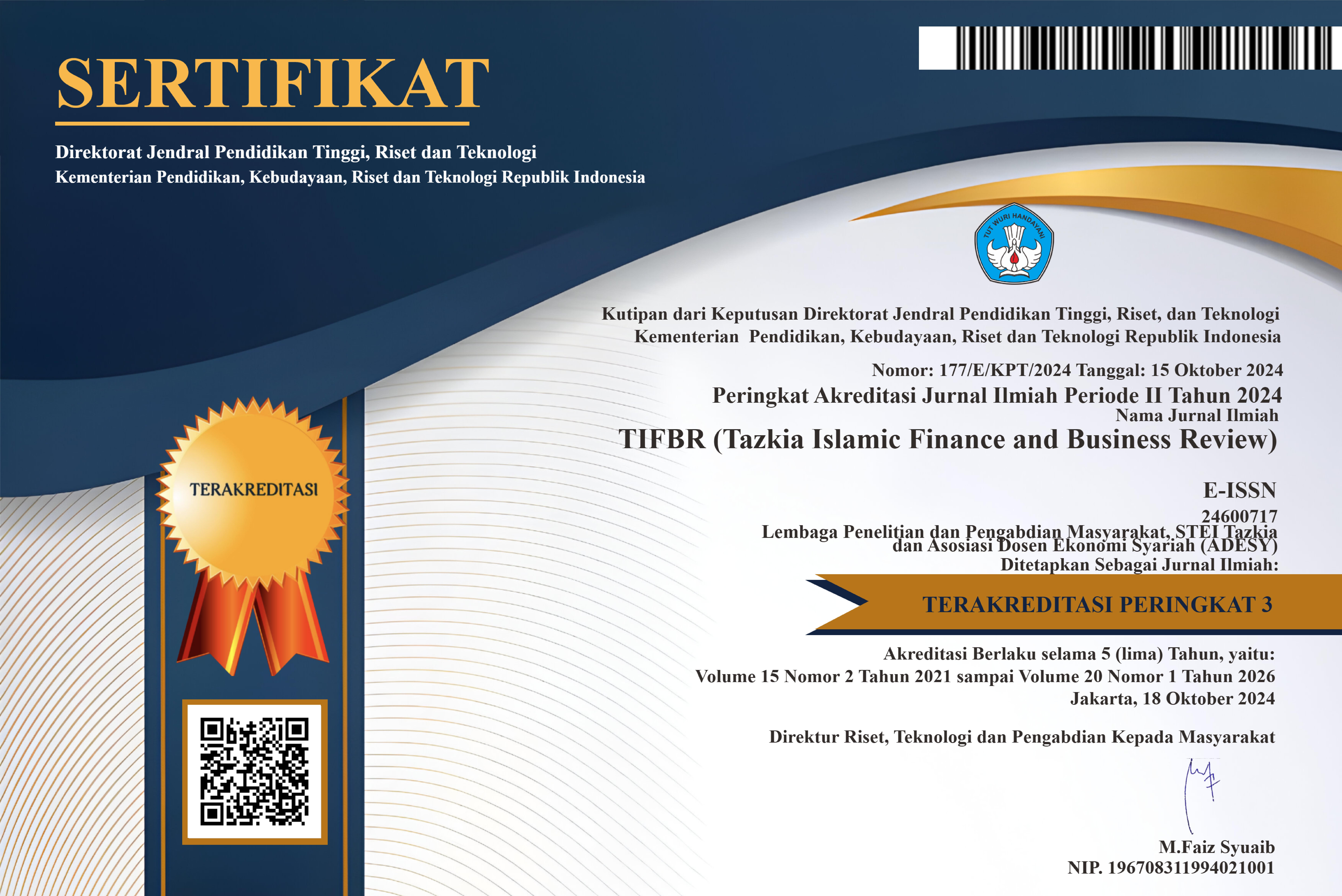A Service Quality of Islamic Microfinance Institutions in Indonesia: An Importance-Performance Analysis Approach
DOI:
https://doi.org/10.30993/tifbr.v12i1.110الكلمات المفتاحية:
Service Quality، Islamic microfinance، Importance-Performance Analysis، Islamic cooperativesالملخص
The rapid growth of financial system in Indonesia creates an intensive competition between Conventional and Islamic financial institutions. The study aims to evaluate the service quality of Islamic Microfinance Institution in Indonesia. The survey was carried out to acquire data from 126 respondents. Descriptive statistics and importance performance analysis (IPA) was used to analyze the data. The finding show that attributes plotted in quadrant “keep up the good work” are providing prompt service, and helpful response to customer requests, Ability in providing services to the customer as needed, prompt service on financial counselling, Ability of staff in giving proper explanation to the customer, Ability to keep the transaction process secure, and Sharia compliance banking products. Meanwhile, the attributes plotted in quadrant “concentrate here” are accessible of location of ATM, easy to access the location, ability to navigate customer to find what they intend, ability to maintain accuracy of bank statement, and ability in providing after sale services. To the best of author’s knowledge, it is the first study that measuring the service quality of Islamic microfinance from customer perspective using importance-performance approach.
المراجع
Akhtar, M. N., Hunjra, A. I., and Akbar, S. W. (2011). Relationship Between Customer Satisfaction and Service Quality of Islamic Banks. World Applied Siences Journal, Vol. 13(3): 453-459.
Bashir, M. S. (2012). Analysis of Customer Satisfaction with the Islamic Banking Sector: Case of Brunei Darusallam. Asian Journal of Business and Management Sciences, Vol. 2(10): 38-50.
Dolinsky, A. (1991). Considering the Competition in Strategy Development: An Extension of Importance-Performance Analysis. Journal of Health Care Marketing, Vol. 11(1): 31-36.
Ferawati, R. (2015). Dampak Pembiayaan LKMS berdasarkan Garis Kemiskinan. Retrieved from http://fem.ipb.ac.id/d/iqtishodia/2015/Iqtishodia_20151126. pdf
Go, F. and Zhang, W. (2008). Applying Importance-Performance Analysis to Beijing as an International Meeting Destination. Journal of Travel Research, Vol. 35(1): 42-49.
Hacket, C. et al. (2015). The Future of World Religions: Population Growth Projections, 2010-2050. Pew Research Center. Washington DC.
Hsu, C. H. C., Byun, S., and Yang, I. S. (1997). Attitudes of Korean College Students Towards Quick-service, Family-style, and Fine Dining Restaurants. Journal of Restaurant and Foodservice Marketing, Vol. 2: 65–85.
Ledgerwood, J. (1999). Microfinance Handbook: An Institusional and Financial Perspective. World Bank, Washington DC.
Khadijah, S. et al. (2013). Sustainability of Islamic Micro Finance Institutions (IMFIs). Journal of Accounting and Finance. DOI. 10.13189/ujaf.2013.010205
Keyt, J. C., Yavas, U., and Riecken, G. (1994). Importance-Performance Analysis: A Case Study in Restaurant Positioning. International Journal of Retail and Distribution Management, Vol. 22: 35–40.
Levesqe, T., and Mcdouglas, G. H. G. (2005). Determinants of Customer Satisfaction in Retail Banking. International Journal of Bank Marketing, Vol. 14(7): 12-20.
Martilla, J. and James, J. (1977). Importance-Performance Analysis. Journal of Marketing, Vol. 41(1): 77-79.
Owusu-Boateng, K. (2012). An Assessment of Customer Satisfaction in the Microfinance Industry: A Case Study of Opportunity International Savings and Loans Limited. Ph.D Thesis. Kwame Nkrumah University of Science and Technology.
Seibel, H. D. and Wahyu, D. A. (2005). Sector Project Financial Systems Development Islamic Microfinance in Indonesia. World Bank Group, Eschborn.
Shafie, S., Asmi, W. N. W., and Haron, S. (2004). Adopting and Measuring Customer Service Quality in Islamic Banks; A Case Study of Bank Islam Malaysia Berhad, The Journal of Muamalat and Islamic Finance Research, Vol. 1(1).
Silva, F. H. and Fernandes, P. O. (2011). Importance-Performance Analysis As A Tool In Evaluating Higher Education Service Quality: The Empirical Results of Estig (IPB). Journal Creating Global Competitive Economics: A 360-Degree Approach: 306-315.
Thaker, H. M., Khaliq, A., and Thaker, M. A. (2016). Evaluating the Service Quality of Malaysian Islamic Banks: An Importance-Performance Analysis Approach. International Journal of Business and Information, Vol. 11(3).
Wong, M. S., Hideki, N., and George, P. (2011). The Use of Importance-Performance Analysis (IPA) in Evaluating Japan E-Government Services. Journal of Theoretical and Applied Electronic Commerce Research, Vol. 6(2): 17-30.
التنزيلات
منشور
كيفية الاقتباس
إصدار
القسم
الرخصة

Tazkia Islamic Finance and Business Review (TIFBR) is licensed under a Creative Commons Attribution-NonCommercial 4.0 International License.
Authors who publish with this journal agree to the following terms:
- Authors retain copyright and grant the journal right of first publication with the work simultaneously licensed under a Creative Commons Attribution License that allows others to share the work with an acknowledgment of the work's authorship and initial publication in this journal.
- Authors are able to enter into separate, additional contractual arrangements for the non-exclusive distribution of the journal's published version of the work (e.g., post it to an institutional repository or publish it in a book), with an acknowledgment of its initial publication in this journal.
- Authors are permitted and encouraged to post their work online (e.g., in institutional repositories or on their website), as it can lead to productive exchanges, as well as earlier and greater citation of published work (See the Effect of Open Access).
















